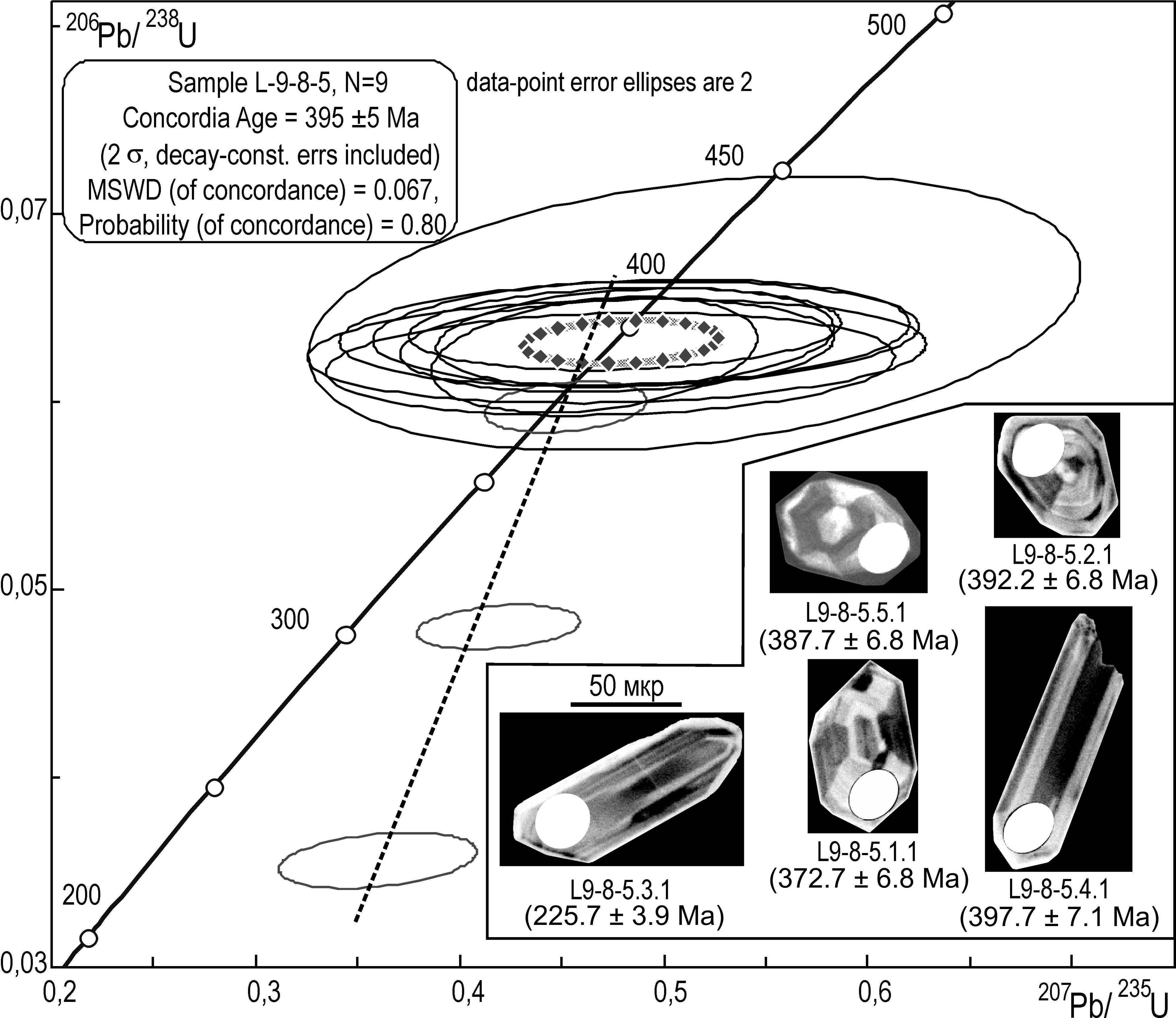|
PLAGIOGRANITES OF THE SOBSKY COMPLEX (POLAR URAL): U-PB DATA Udoratina O.V.*, Kusnetsov N.B.**, Larionov A.N.*** *Institute of Geology of Komi SC UrB RAS, Syktyvkar, Russia, udoratina@geo.komisc.ru **Geological Institute of RAS, Moscow, Russia, kouznikbor@mail.ru ***Isotope Research Center of VSEG EI, Sankt-Petersburg, Russia, Alexander_Larionov@vsegei.ru
The Sobsky batholite-like massif is located in the Lesser Ural area of the Polar Ural immediately south-eastward from Voykaro-Synya and Rayiz ophiolite massifs (Fig.1). The Middle Paleozoic volcanogenic-sedimentary formations are distributed south-eastward from the Sobsky massif; their SE edge is overlaid by Mz-Kz complexes of the cover of the South-Eastern Western Siberian plate. General data on the structure of the Sobsky massif and investigation history of composing intrusive associations (complexes) have been described in detail previously (Udoratina et al, 2000, Udoratina, Kusnetsov, 2007). Here we just specify that the massif stretches south-eastward for more than 200 km with maximal width 10-15 km. The massif is formed by three intrusive complexes: plagiogranitoids of the Early Devonian Sobsky complex, biotite granites and leucogranites of the Middle Devonian Yanaslor complex, and also by monzonites and monzodiorites of the Early carboniferous (?) Kongor complex. The Sobsky plagiogranitoids compose the general part of the massif of the same name. They are represented by tonalites, plagiogranites, granodiorites and other rocks. K-Ar and Rb-Sr based age of the complex is estimated as Early Devonian – 404-408 Ma (Starkov, 1985), 400±10 Ma (Geochemistry.., 1983), 404±5 Ma (Andreichev, Udoratina, 2000), 399±24 Ma (Andreichev, 2004).
Fig. 1. Sobsky intrusive complex and its position in Polar Ural. 1 – Mz-Kz complexes of the cover of Western Siberian Plate; 2 – non-segmented Late Precambrian and Pz complexes of the Western Ural megazone; 3-5 – Pz complexes of East Ural megazone: 3 – early-middle-Pz(?) basite-ultrabasites of Voykar-Rayiz zone; 4 – middle-Pz volcanogenic sedimentary complexes of the Lesser Ural zone; 5-7 – Sobsky (5), Yanaslor (6) and Kongor (7) complexes of the Sobsky massif; 8 – plagiomigmatite of NW contact of the Sobsky massif; 9 – the same, rupture complicated; 10 – boundary of the Western and East Ural megazones; 11 – large faults.
Additionally we carried out U-Pb dating of zircons from the rocks of the complex. For this purpose the coarse-grained granodiorites L-9-8-5 were sampled (from collection by P.M.Kucherina, sampling place – watershed of rivers Tan-Yu and B.Lagorta, see Fig. 1). The rocks are rose-grey, massive and small-grained, with hypidiomorphic microstructure, composed of (vol. percent) plagioclase (up to 70), hornblende (up to 10), quartz (10-15) and insignificant quantity of potash feldspar. The order of decreasing idiomorphism Hb>Pl>PFS. The hornblende is substituted by biotite and chlorite; plagioclase – by sericite and epidote. Accesssory minerals are represented by apatite, allanite, rutile, zircon and leucoxene. Ore minerals – by magnetite, pyrite and chalsopyrite. The zircons were determined in the Institute of Geology of Komi SC UB RAS (Syktyvkar) and dated (SHRIMP) in CII VSEGEI (Sankt-Petersburg). They are transparent colorless crystals with long prismatic to short prismatic form. The oscillation zonation is observed in the crystals (Fig.2). In total 9 analyses have been done, each consisted of 5 mass-spectra for the following masses: 196(Zr2O), 204Pb, Background (c. 204.2 AMU), 206Pb, 207Pb, 208Pb, 238U, 248ThO, and 254UO. Contents of U and Th – 0.35-1.10, and 85-805 g/t, accordingly, and value Th/U – from 0.35 to 1.10. Data processing was carried out according to (Williams et al, 1998) by the program (Ludwig, 1990). U/Pb ratios were normalized relatively to 206Pb/238U – 0.0668, corresponding to Temora zircons (416.75 Ma). The obtained average age (confidence interval 95%) made 395±5 Ma (Fig. 2), which proves the notion about the Early Devonian age of Sobsky plagiogranides and closely corresponds to the known Rb-Sr of these rocks.
Fig. 2. Diagram with Concordia for zircons from granodiorites of the Sobsky complex. Below to the right – CL-images of the studied zircons selectively. References Andreichev V.L. Isotope geochronometry of ultramafite-mafite and granitoid associations of the Eastern slope of the Urals. Syktyvkar: Geoprint, 2004. 44p. (in Russian) Andreichev V.L., Udoratina O.V. New data on the age of granitoids of Kongor complex // Isotope dating of geological processes: new methods and results. GEOS. Moscow. 2000. P.8-30. (in Russian) Isotope Geochemistry in Polar Ural ophiolites. Moscow, Nauka, (Works of GIN AN USSR, issue 376). 1983. 183p. (in Russian) Starkov V.D. Intrusive magmatism of eugeosyncline zones of Polar Ural. Sverdlovsk. UNC AN USSR, 1985, 384p. (in Russian) Udoratina O.V. Kusnetsov N.B. Pavlenko T.I. Sobsky complex granitoids (Polar Ural) // Petrology of magmatic and metamorphiñ complexes. Tomsk: CNTI, 2000. P.82-86. (in Russian) Udoratina O.V. Kusnetsov N.B. Late Granitoid dykes of the Sobsky complex (Polar Ural)// Geology of the European North of Russia. Ed. 5. Syktyvkar, 2001. P.64-72 (Works of Institute of Geology of Komi Science Center of UB RAS; Issue 108). (in Russian) Udoratina O.V. Kusnetsov N.B. Sobsky plagiogranite complex of Polar Ural // Bulletin of MOIP, Geological Dep. 2007. Vol.82, Issue 3. Ð.49-59 (in Russian) Ludwig K.R. // US Geol. Surv. Open-File Report 88-557. 1990. 38p. Williams I.S., McKIbben, M.A., Shanks III, Ridley W. I. Reviews in Economic Geology, 7, 1998. Ð.1-35.
|

